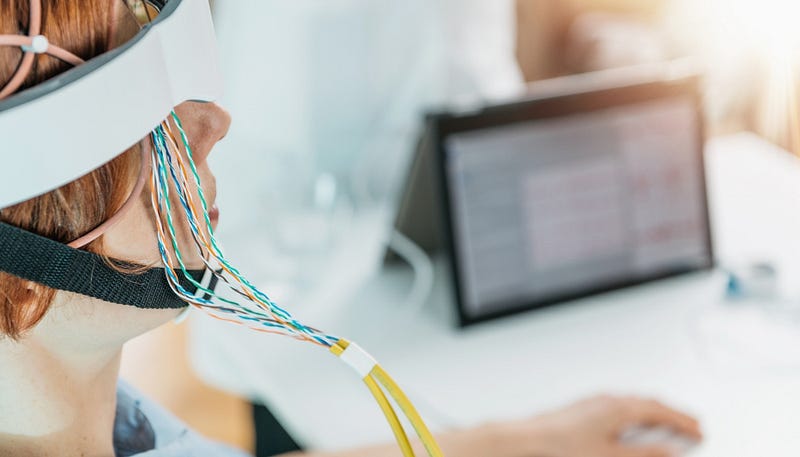Brain Monitoring Shows How to Avoid Being Duped on Social Media
Research on scrolling with skepticism finds asking yourself key questions activates the critical thinking centers of the brain.
Based on the research of Tricia Moravec

Stopping misinformation on social media involves asking ourselves a question: How do I know this news headline is true?
Tricia Moravec, Texas McCombs assistant professor of information, risk, and operations management, discovered that asking people to reflect on their experiences while scrolling through headlines on social media nudges them to become more skeptical of the articles they see. Otherwise, we tend to accept articles that fit with our prior beliefs.
“We’re all at risk of believing misinformation, and we’re susceptible to it,” says Moravec. “When we ask people these so-called self-referential questions, it helps them think more critically, not only about the headlines they see but also subsequent headlines.”
Deeper Thinking
In a new study, Moravec, along with Antino Kim and Alan R. Dennis of Indiana University and Randall K. Minas of the University of Hawaii, asked participants to first rate 14 randomly assigned headlines on their truthfulness and believability.
Of 42 total headlines from fabricated source NewsUnion.com, the researchers designed 16 to appeal to politically left-leaning participants and 16 to right-leaning ones. The remaining 10 headlines discussed local events. The person posting the articles on the mocked-up social media page was given a gender-neutral name, and the comment in the post was a summary of the news headline. Half of the headlines were verified to be true and half were verified to be false at the time of the study.
The made-up headlines that participants read on a computer screen included “Trump Calls for Death Penalty for NYC Truck Attack Suspect,” “Anti-Abortion Congressman Tim Murphy Urges His Mistress to Have an Abortion,” and “County Food and Beverage Tax Only Incurred by Out of State Residents.”

Next, the researchers asked participants to rate 28 more headlines in random order. For 14 of the 28 headlines, participants looked at the headline and then answered a self-referential question that asked how much personal knowledge participants had of a given news item: “How truthful is this story?” Participants selected from choices including:
· I have personal knowledge of this story and it’s true
· I have personal knowledge and it’s false
· I have no personal knowledge, but it seems true
· I have no personal knowledge, but it seems false
· I cannot tell whether it’s true or false
For the other 14 headlines, the researchers did not ask the self-referential question. All study participants wore an EEG headset so researchers could measure neurophysiological changes as they evaluated headlines.
Moravec and her fellow researchers found that users who rated articles accompanied by the self-referential question had increased activation in several parts of the brain associated with deliberate cognitive activity, including the medial prefrontal cortex.
The question triggered some participants to pause and realize they had no firsthand way to evaluate the credibility of the news story — unless they personally experienced the event. Participants thought more deeply about the news piece rather than quickly giving in to the knee-jerk reaction that articles aligned with their prior beliefs are true.
“People were more skeptical when they saw headlines with the self-referential rating,” Moravec says. “This allows the end user to have a way to be more responsible with their own social media use and what they end up believing. It gives them more autonomy.”
The researchers also noticed that the effect of the self-referential questions seemed to linger. Participants who answered a self-referential question while viewing a headline continued to critically analyze content even when they weren’t prompted to do so by a new self-referential question.
Cutting Down on Misinformation
For social media companies, adding a self-referential question alongside posted news articles could help to curb the spread of misinformation as users scroll through their feeds and share articles on Facebook and other sites. It’s a step toward more mindful consumption, says Moravec.
Yet, Moravec is skeptical that social media companies will jump on the opportunity. People tend to turn to social media for entertainment, connecting with friends, or escapism, and being asked a self-referential question that requires cognitive effort might not be enjoyable. Social media companies are unlikely to pursue anything that could irritate users and cut into their profits, she says.
Future research should focus on how to help people to believe true information, and the best ways to direct users toward reputable news, she says.
Moravec, for her part, says she steers clear of Facebook and other social media sites, partly because of the widespread misinformation. “We also know social media can have negative effects on some people’s mental health,” she says. “I recommend that people be intentional about their social media use.”
She suggests cross-referencing information seen on social media with official sources or news agencies such as The Associated Press because, although approaches like including self-referential questions with news content can help, they won’t totally eliminate misinformation.
“There’s always going to be misinformation getting to the end user,” says Moravec. “All we can do is try to make some progress that might help.”
“Do You Really Know if It’s True? How Asking Users to Rate Stories Affects Belief in Fake News on Social Media” is forthcoming, online in advance in Information Systems Research.
Story by Deborah Lynn Blumberg


